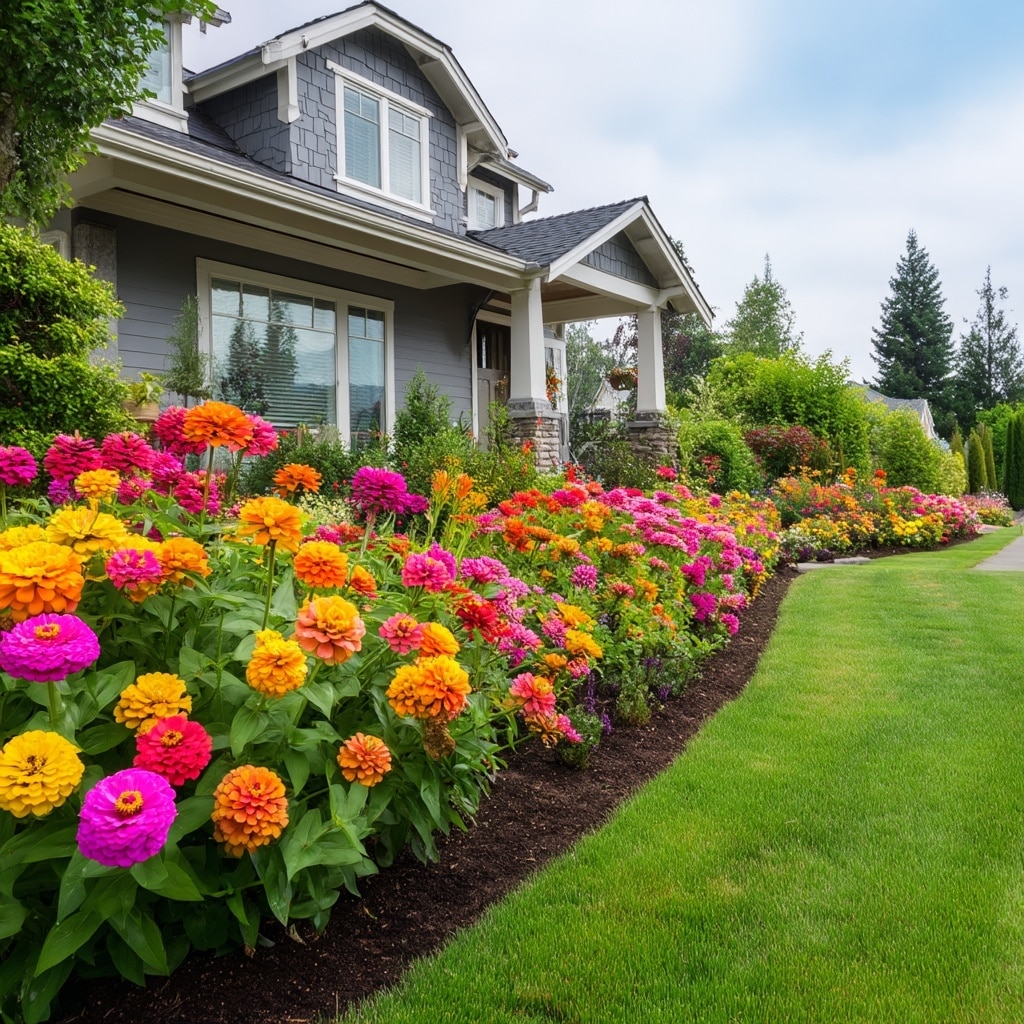Zinnias garden ideas are one of the easiest ways to bring bold color, charm, and seasonal joy to any outdoor space. With their low-maintenance nature and stunning variety of shapes and hues, zinnias can transform even a small corner of your yard into a blooming paradise. Whether you’re working with a large backyard or a compact front patch, these cheerful blooms offer endless layout possibilities that feel both cozy and eye-catching. In this guide, we’ll walk through ten inspiring zinnia garden bed setups—each crafted to help you create a vibrant, welcoming yard that’s as joyful to tend as it is to admire.
Table of Contents
1. Create a Rainbow Zinnia Border Bed
Nothing turns heads quite like a carefully layered zinnias garden idea that mimics the colors of a rainbow. This flower bed concept isn’t just visually stunning—it also makes the most of zinnias’ natural variety in both height and hue. It’s an ideal layout for gardeners who love order with a splash of personality.
Plan Your Garden Like a Color Wheel
Start by measuring out a space that’s at least 6 feet deep by 10–12 feet wide. This gives your zinnias plenty of room to show off without looking cramped. Sketch out your bed on paper or digitally, paying attention to the sun’s path—zinnias thrive in full sun, so choose a spot with 6–8 hours of direct light daily.
Use Height to Your Advantage
To create that layered, gradient look, group zinnia varieties by size:
- Back row: Tall types like Benary’s Giant or California Giant (up to 4 feet)
- Middle row: Medium varieties like the Oklahoma Series (2–3 feet)
- Front row: Dwarf zinnias like Thumbelina or Lilliput (under 1 foot)
This tiered layout gives your garden bed a “stadium seating” effect, making every color visible from the front.
Build the Rainbow, Naturally
Arrange your zinnias by color bands in traditional ROYGBIV order:
- 🔴 Red: ‘Scarlet Flame’, ‘Benary’s Giant Red’
- 🟠 Orange: ‘Profusion Orange’, ‘Oklahoma Salmon’
- 🟡 Yellow: ‘Canary Bird’, ‘Gold Medal’
- 🟢 Green: ‘Envy’ zinnias (a chartreuse standout)
- 🔵 Blue: Add blue salvia, bachelor’s buttons, or lobelia as companions
- 🟣 Purple: ‘Purple Prince’, ‘Benary’s Giant Lilac’
Using companion plants in the blue range helps complete the spectrum, as true-blue zinnias are rare.
Add Framing for a Polished Look
Define your border with natural stone, brick, or metal edging. It helps maintain structure and keeps mulch, soil, and color sections neatly in place. A clear edge also makes your garden bed look intentional and maintained, even in peak bloom chaos.
Extra Touch: Pollinator-Friendly Boost
Zinnias already attract butterflies and bees, but you can boost biodiversity by planting nectar-rich companions like verbena bonariensis, cosmos, or bee balm throughout the bed. These provide vertical interest and help support your local ecosystem.
2. Design a Cottage-Style Zinnia Garden
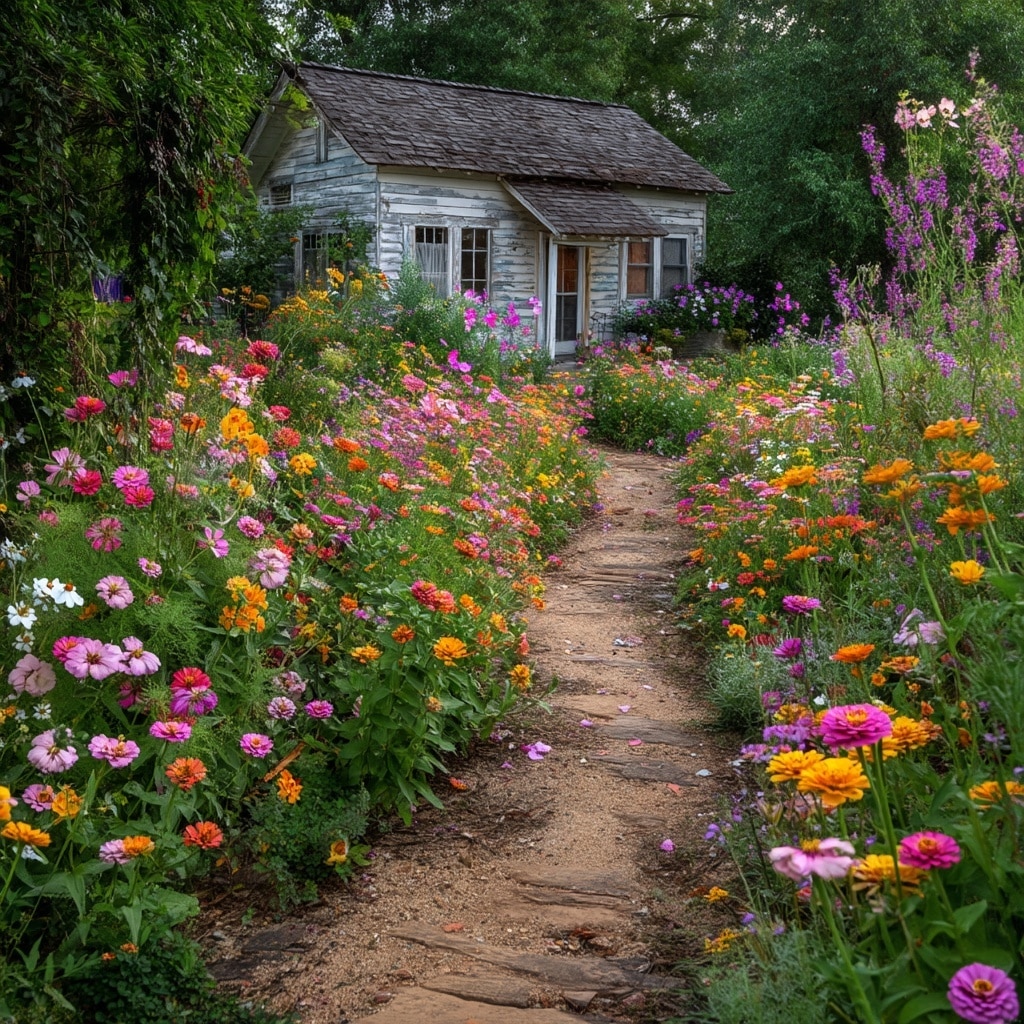
If you love that wild, romantic look with layers of blooms spilling over one another, a cottage-style layout is one of the coziest zinnias garden ideas you can plant. This style works beautifully with zinnias thanks to their bright colors, upright form, and long-lasting blooms—all perfect for recreating that effortless “English garden” feel.
Blend Blooms, Don’t Isolate Them
Instead of planting zinnias in tidy rows, intermix them with other soft, old-fashioned flowers. Think of your garden bed like a natural tapestry, not a grid. Use a mixture of annuals and perennials that bloom at different times to keep the bed looking full and lively throughout the season.
Ideal companion plants include:
- Snapdragons – for vertical pops and pastel shades
- Foxgloves – tall and elegant, contrast well with shorter zinnias
- Cosmos – airy texture that breaks up dense clusters
- Yarrow and catmint – soft fillers that keep pollinators busy
Layer your zinnias between these plants in scattered clumps rather than uniform blocks. This gives the space a more organic, cottage-inspired flow.
Focus on Warm and Muted Tones
While zinnias come in every color under the sun, choose softer or romantic hues to suit this aesthetic—pinks, peaches, creams, and purples. Look for varieties like:
- Zinderella Lilac
- Queen Lime Blush
- Oklahoma Pink
- Benary’s Giant Wine
These shades harmonize with traditional cottage flowers and keep the bed from becoming too visually chaotic.
Mulch Lightly, Let It Breathe
Unlike modern garden beds with tight borders, cottage-style zinnia beds look best with soft edges. Use natural mulch like shredded bark or straw and allow a little spillover into nearby grass or paths. It creates that lived-in, loved look that defines the cottage vibe.
3. Build a Pollinator Paradise with Zinnias

One of the most rewarding zinnias garden ideas is creating a haven for bees, butterflies, and hummingbirds. Zinnias are rich in nectar and bloom continuously, making them a magnet for pollinators—and a joy to watch.
Choose Single-Petal Varieties for Better Access
While double zinnias are showy, single-petal types make it easier for pollinators to land and feed. Prioritize open-centered varieties like:
- ‘Cut and Come Again’ – reliable, easy to grow, blooms nonstop
- ‘Lilliput Mix’ – compact but loaded with pollinator-attracting flowers
- ‘Zinnia elegans’ heirloom strains – often more accessible than hybrids
Plant in dense patches to provide a continuous food source throughout the growing season.
Go Native and Add Nectar-Rich Companions
To boost the biodiversity of your pollinator bed, pair zinnias with native wildflowers and other pollinator favorites. Try a mix of:
- Milkweed – for monarch caterpillars and butterflies
- Bee balm (Monarda) – loved by hummingbirds and bees
- Coneflowers – sturdy and long-blooming
- Black-eyed Susans – add structure and rich pollen
- Lavender or mint – gentle fragrance plus pollinator draw
Mix these plants in layers, with taller species in the back and low-growing varieties up front to create a balanced habitat.
Don’t Deadhead Everything
While zinnias benefit from regular deadheading to prolong blooming, let a few go to seed by late summer. Birds, especially finches, will snack on the dried seed heads—adding another dimension to your wildlife-friendly garden.
Water Shallowly, Mulch Smartly
Pollinators love warm, sunny, open gardens, but they also need water. Add a shallow birdbath with stones for perching, or even a dish with damp sand for butterflies. Mulch around plants to retain moisture, but leave a few bare patches for ground-nesting bees.
4. Small-Space Zinnia Bed for Urban Gardens
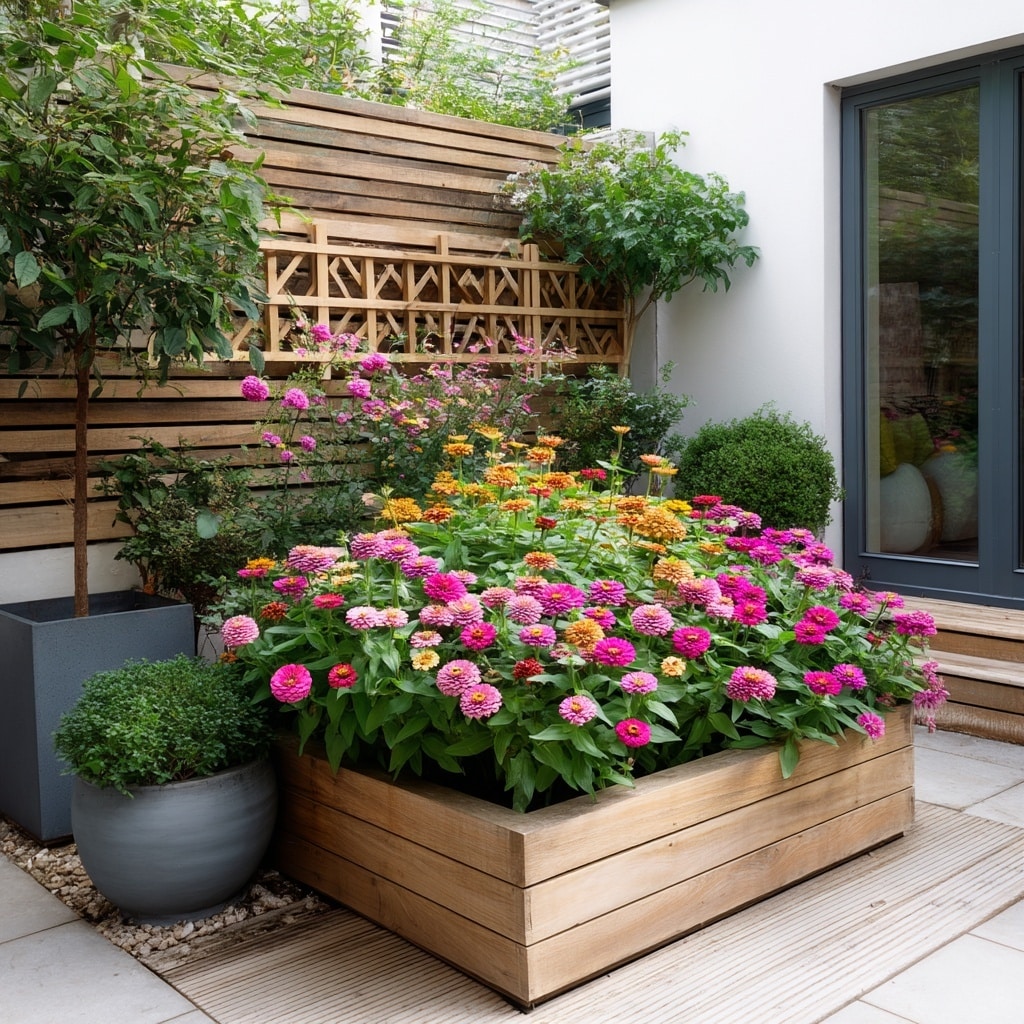
Not every garden needs acres of land to shine. Some of the most charming zinnias garden ideas come from creative use of compact spaces—think raised beds, containers, or narrow strips along fences. With their upright habit and long-lasting blooms, zinnias thrive in small beds with minimal fuss.
Choose Compact or Dwarf Varieties
In tight quarters, look for zinnias that stay small but still deliver vibrant blooms. Great options include:
- ‘Profusion Series’ – low-growing, disease-resistant, and continuous bloomers
- ‘Thumbelina Mix’ – adorable at just 6–10 inches tall
- ‘Zahara Zinnias’ – compact, with excellent drought tolerance
These stay neat and tidy without sacrificing flower power, making them ideal for pots, window boxes, or narrow raised beds.
Use Vertical Elements to Maximize Space
Add a trellis, fence panel, or obelisk behind your zinnias and pair with tall companions like morning glories, sweet peas, or even a few climbing beans. This vertical layering makes the most of your garden footprint while giving pollinators more to explore.
Create a “Zinnia Strip” Along Paths or Fences
Got a 1–2 foot-wide patch along your driveway or between a sidewalk and fence? Fill it with alternating dwarf and medium zinnias for a stunning sidewalk border. Add ornamental grasses, alyssum, or creeping thyme at the base to soften the edges and fill gaps.
Containers? No Problem.
Zinnias grow beautifully in pots—just use a container at least 10–12 inches deep, and ensure it has well-draining soil. Use a quality organic potting mix and fertilize every few weeks with a balanced, low-nitrogen fertilizer to keep blooms going strong.
Bonus: Containers are easy to rearrange, which means you can rotate zinnia displays for constant curb appeal all summer long.
5. Zinnia Cutting Garden Bed for Endless Bouquets
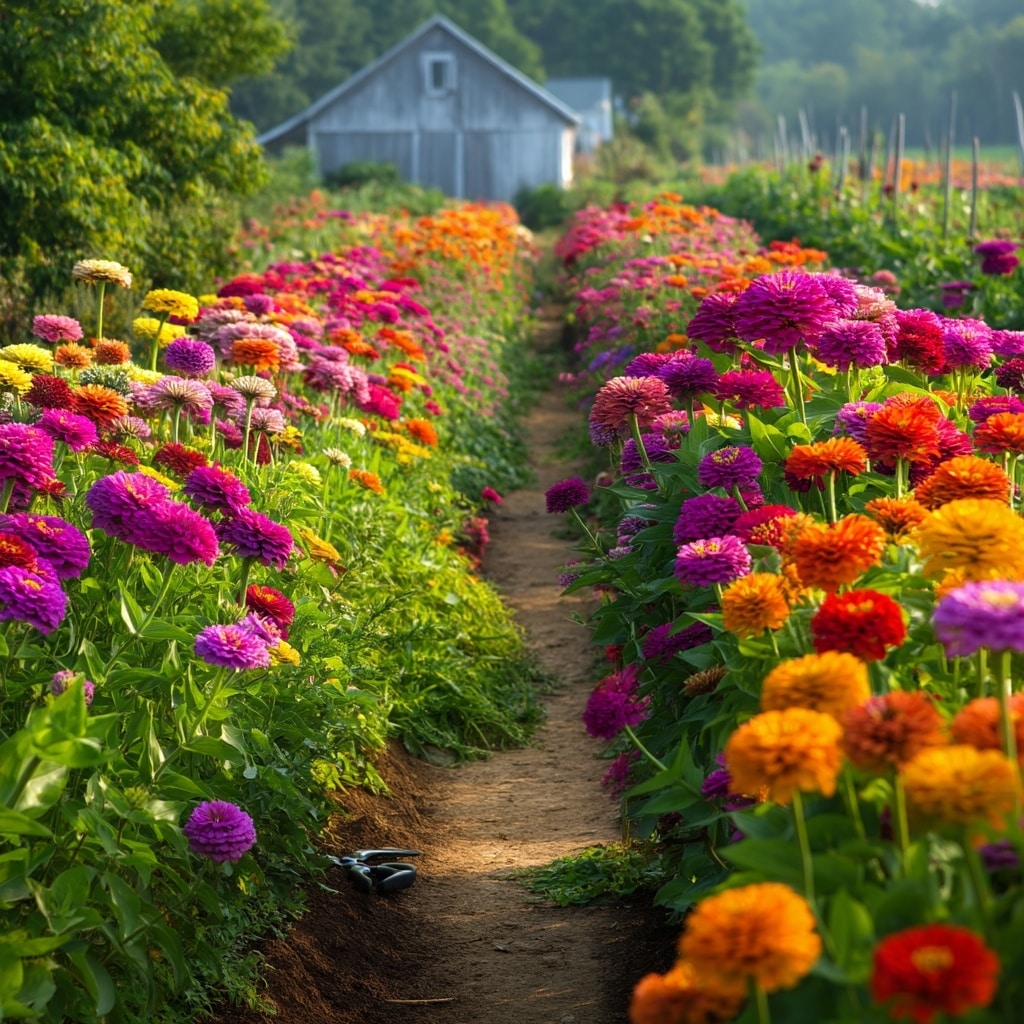
If you’re someone who dreams of filling your home with fresh flowers all summer long, a dedicated zinnias garden idea built for cutting is the way to go. Zinnias are among the best cut flowers out there—long stems, bold colors, and blooms that last over a week in a vase.
Prioritize Stem Length and Repeat Bloomers
Focus on tall zinnia varieties bred specifically for cutting. They’ll give you strong, straight stems and keep producing more the more you harvest. Top picks include:
- ‘Benary’s Giant’ – florist favorite for size and vase life
- ‘State Fair Mix’ – big, colorful blooms with good height
- ‘Uproar Rose’ – vivid magenta with sturdy stems
- ‘Queen Lime Series’ – unique coloring and excellent structure
Plant in rows or clusters with at least 12 inches of spacing to promote air circulation and easier harvesting.
Stagger Your Plantings
To ensure a steady supply of flowers, plant successive batches of zinnia seeds every 2–3 weeks from spring through midsummer. This way, you won’t be overloaded with blooms at once—and you’ll extend your harvest window into fall.
Grow in Rows with Easy Access Paths
A cutting garden is all about function, so arrange your zinnias in tidy rows with small footpaths (even just straw or stepping stones) to allow quick, clean access. This also helps reduce soil compaction and prevents damaging plants while harvesting.
Use Mulch and Drip Irrigation
Because cutting beds are high-production zones, you’ll want to conserve water and reduce disease pressure. Apply a 2–3 inch mulch layer to suppress weeds, and consider using drip irrigation for consistent moisture at the base—keeping leaves dry and flowers healthy.
Harvest Often to Keep the Blooms Coming
Once your zinnias start producing, cut daily or every other day. Snip stems early in the morning, just above a leaf node, and immediately place them in water. The more you cut, the more they’ll bloom—zinnias are generous like that.
6. Drought-Tolerant Zinnia Bed for Hot Climates
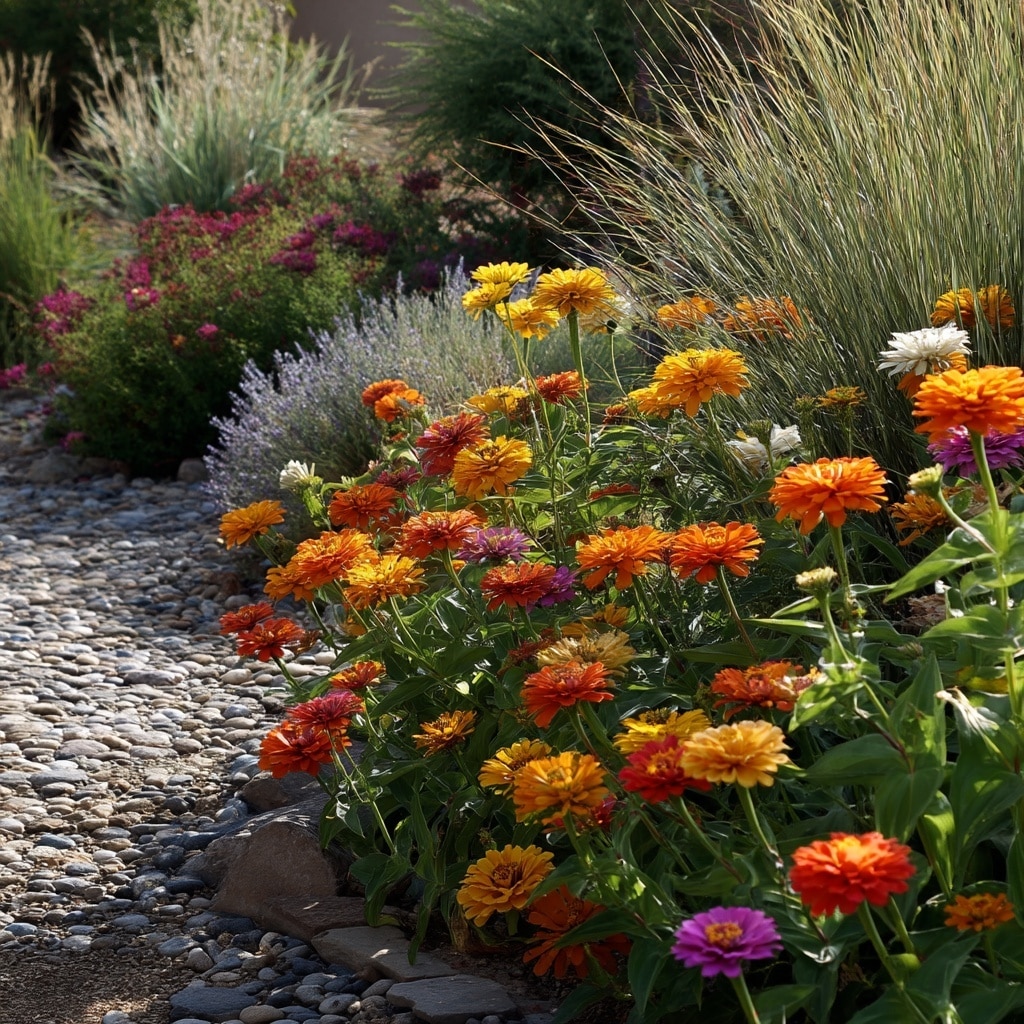
If you garden in a region where water conservation is key, you’ll be happy to know that many zinnias garden ideas hold up beautifully in dry, sunny conditions. Zinnias are naturally drought-tolerant once established, making them ideal for xeriscaping or low-maintenance garden beds.
Choose Heat-Loving, Resilient Varieties
For best performance in hot climates, go with zinnias that have been bred for resistance to powdery mildew and can handle extended dry spells. Look for:
- ‘Zahara Series’ – bred for heat and drought resistance
- ‘Profusion Series’ – compact and carefree
- ‘Old Mexico’ – heirloom beauty with strong sun tolerance
- ‘Crystal White’ – a tidy, compact option that reflects heat and looks clean
These varieties thrive in direct sunlight and don’t sulk between waterings like more delicate flowers might.
Use Gravel Mulch and Heat-Reflective Elements
Swap out bark mulch for pea gravel, decomposed granite, or crushed stone. These materials help retain moisture at the root level while reflecting heat and light upward—great for sun-loving zinnias. Plus, they give your garden a clean, Mediterranean-inspired aesthetic.
Mix with Other Drought-Tolerant Plants
Design your bed with hardy companions that love the heat too. These add texture and create microclimates that help all your plants thrive.
Good pairings include:
- Russian sage – adds height and silvery contrast
- Sedum – succulent foliage and late blooms
- Coreopsis – long bloomers that match zinnia energy
- Ornamental grasses – soften edges and tolerate dry soil
Together, they form a cohesive garden bed that looks intentional—and survives heatwaves without a meltdown.
Water Deeply, But Infrequently
Encourage deep root systems by watering thoroughly but less often. Once your zinnias are established, aim for one deep watering per week. Avoid overhead watering to reduce disease risk; a soaker hose or drip system is ideal.
7. Monochrome Zinnia Garden Bed for Bold Simplicity

Sometimes, the most striking zinnias garden ideas aren’t the busiest or most colorful—they’re the most focused. Designing a zinnia bed using a single color family can create a strong visual impact, add cohesion to your landscape, and highlight the unique forms and textures of each bloom.
Pick Your Palette and Stick With It
Start by choosing a single dominant color—like white, pink, red, or orange—and build your garden around various shades within that family. For example:
- All-white zinnia bed: ‘Crystal White’, ‘White Wedding’, ‘Zahara White’
- Blush & pink tones: ‘Zinderella Lilac’, ‘Oklahoma Pink’, ‘Profusion Cherry’
- Red-hot theme: ‘Benary’s Giant Scarlet’, ‘Cut and Come Again Red’, ‘Magellan Red’
- Sunset oranges: ‘Profusion Orange’, ‘Persian Carpet’, ‘Zahara Scarlet’
These monochrome beds feel intentional and modern, especially when contrasted with deep green foliage or neutral hardscaping.
Use Texture and Height for Interest
To avoid a flat look, vary the heights, petal types, and bloom sizes within your chosen color family. Mix in:
- Pom-pom styles (like Zinderella)
- Classic daisy forms
- Single vs. double petals
- Tall and dwarf varieties
This adds depth without deviating from your theme.
Companion Plants Should Support, Not Compete
Stick with foliage and blooms that complement rather than compete. In a pink-themed bed, for example, silver-leaved plants like dusty miller or lamb’s ear offer soft contrast. In a red bed, try dark-leaved coleus or bronze fennel for visual grounding.
Create a Strong Border or Shape
Monochrome beds work especially well in geometric shapes—circles, squares, or sweeping arcs. Use brick edging, stone, or evergreen shrubs to define the shape and make the color theme pop even more.
8. Edible Companion Zinnia Garden for Vegetable Beds
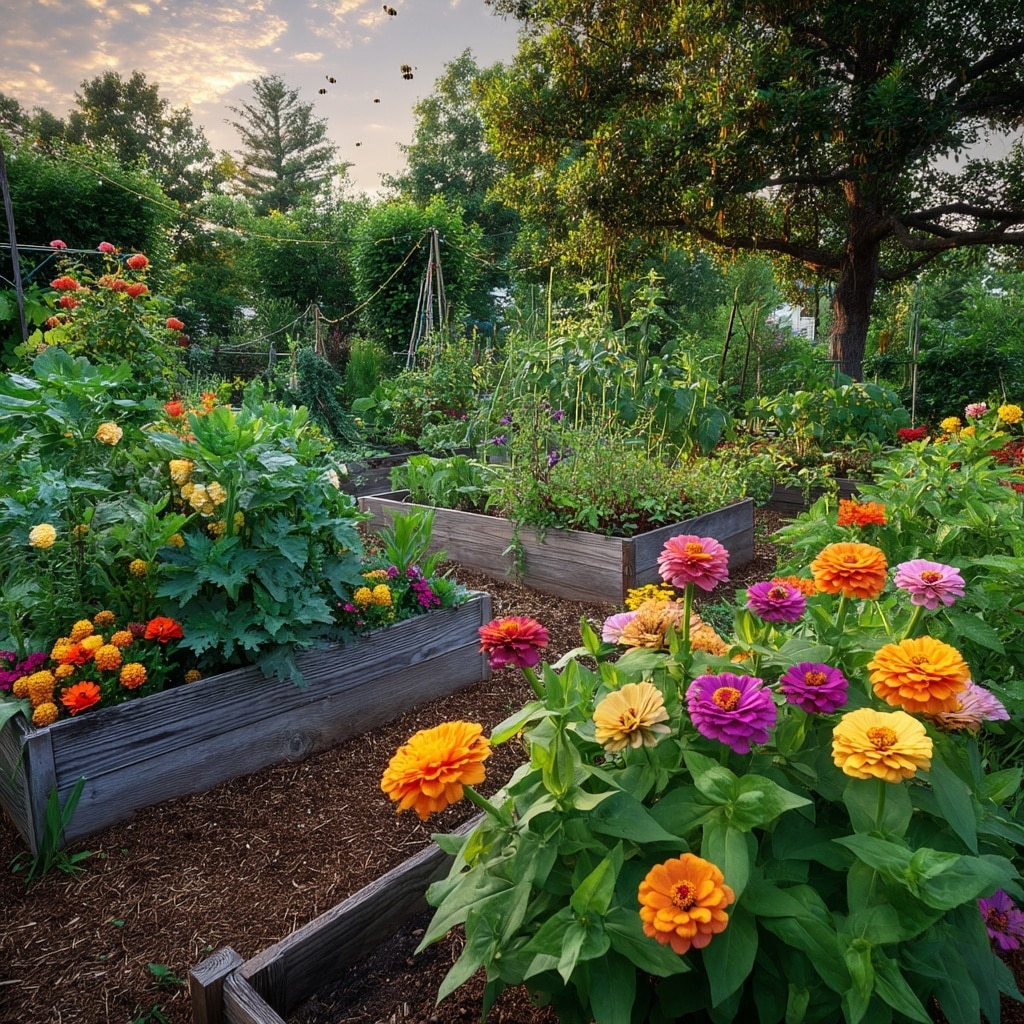
Want a garden that feeds both your eyes and your plate? Integrating zinnias into your vegetable garden is one of the most beneficial zinnias garden ideas you can try. These bright blooms attract pollinators, repel pests, and add a burst of color among your crops.
Zinnias: The Unsung Heroes of Companion Planting
Zinnias are excellent companions for many vegetables, especially those that need help with pollination or protection from pests. Their bold colors lure in:
- Bees and butterflies – to boost fruit set on crops like cucumbers, squash, and tomatoes
- Hoverflies and ladybugs – to control aphids and other soft-bodied insects
- Hummingbirds – which can help keep down pest populations
Plant zinnias along the edges or in between vegetable rows to create “pollinator highways” through your garden.
Best Zinnias for Veggie Gardens
Choose varieties that bloom continuously and don’t overwhelm nearby plants:
- ‘Cut and Come Again’ – compact and persistent
- ‘Profusion Series’ – low-growing and mildew-resistant
- ‘Oklahoma Series’ – medium height, good visibility to pollinators
- ‘Lilliput Mix’ – small but vibrant and bee-friendly
Spacing is key: leave 12–18 inches between zinnias and vegetables to avoid crowding.
Design Tips for Integration
- Corner clusters: Place taller zinnias at the corners of raised beds
- Row borders: Plant dwarf zinnias along the front edge for beauty and function
- Mixed interplanting: Tuck single zinnias between tomato or pepper plants
- Pathway lines: Use them to soften and beautify garden walkways
Pair with basil, nasturtiums, or marigolds for a full-circle edible and beneficial planting strategy.
Bonus: Seasonal Color in Your Harvest Space
Aside from the pollination perks, adding zinnias to your food garden just makes the space more joyful. Even when the tomatoes are slow or the cucumbers are spent, zinnias keep the show going until first frost.
9. Wildflower-Style Zinnia Meadow for a Natural Look
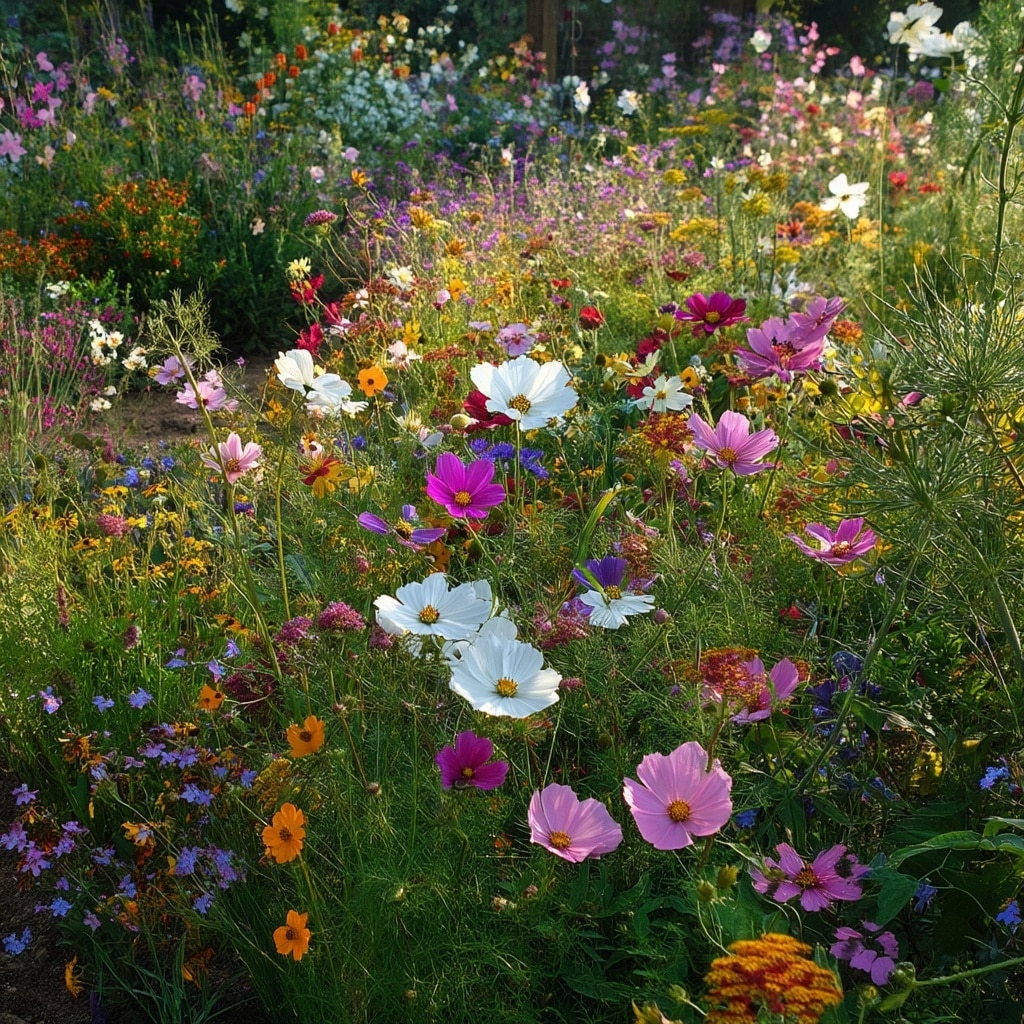
If you’re drawn to untamed beauty and want a landscape that feels alive with movement, texture, and color, a wildflower-style zinnia meadow is one of the most enchanting zinnias garden ideas you can plant. It’s informal, pollinator-friendly, and incredibly easy to maintain.
Go for a Loose, Scattered Layout
Instead of planting in rows or formal beds, scatter zinnia seeds directly into open ground or broad planting areas. Combine them with other easy-growing annuals like:
- Cosmos
- Bachelor’s buttons
- Coreopsis
- California poppies
- Sunflowers (at the back for height)
This blend creates a layered, spontaneous look that changes slightly week by week—just like a true meadow.
Choose Zinnias That Blend In Well
For this look, avoid overly structured or hybridized forms. Opt for simple, open-faced zinnias with a more “wild” feel:
- ‘Cactus Flowered Mix’ – unique textures with a freeform look
- ‘Cut and Come Again’ – blooms endlessly and naturalizes easily
- ‘Persian Carpet’ – smaller blooms in earthy, fall-toned hues
- ‘Lilliput’ – compact but great mixed with wildflowers
Sow thickly for best effect and thin seedlings if needed once sprouted.
Maintain with a Light Touch
- Water only to establish, then let the garden go semi-wild
- Deadhead occasionally to prolong bloom time, but let some go to seed for self-sowing
- Add paths of mown grass or stepping stones to allow access without disturbing the ecosystem
Bonus: You’ll attract bees, butterflies, birds, and even beneficial insects like lacewings and hoverflies, which keep the garden thriving without pesticides.
10. Front Yard Zinnia Display for Instant Curb Appeal
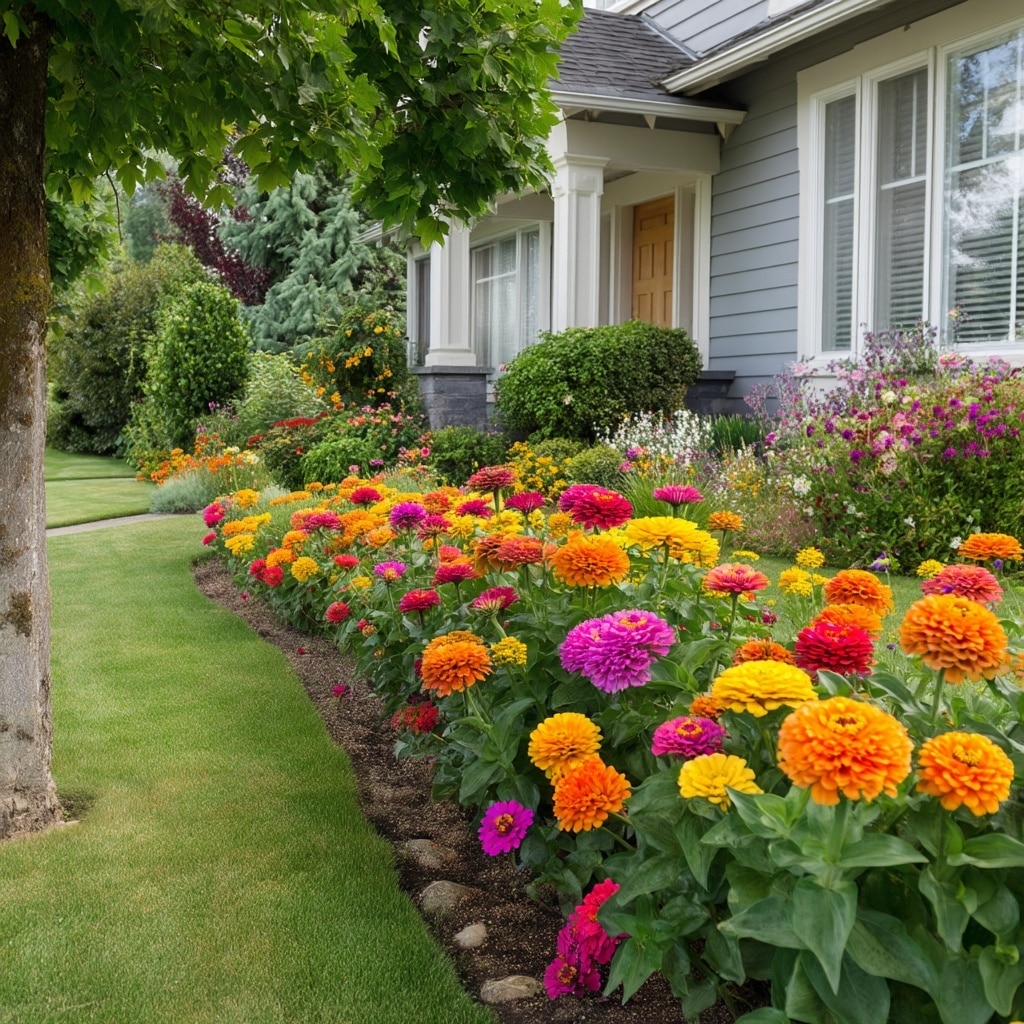
If you’re looking to upgrade your home’s first impression, nothing beats a lush bed of zinnias right in the front yard. It’s one of the simplest zinnias garden ideas to execute—but the payoff is huge: bright color, neat structure, and blooms that greet guests (and pollinators) from early summer to frost.
Pick a Clean, Defined Space
Identify a highly visible spot—along the sidewalk, driveway, front porch, or directly below a bay window. Zinnias do best in full sun, so choose an area that gets at least 6 hours of sunlight per day. Keep the shape simple: oval, semicircle, or a long strip bordered by low hedging or stone.
Go for Show-Stopping Varieties
Choose bold colors and larger blooms for maximum impact. Great options for the front yard include:
- ‘Benary’s Giant Mix’ – tall, bright, and hard to miss
- ‘Zahara Starlight Rose’ – eye-catching pink and white bi-color
- ‘Magellan Mix’ – mid-sized and bushy, perfect for a tidy look
- ‘Queen Red Lime’ – unique, muted tones for a designer vibe
For smaller spaces, try ‘Profusion Double Mix’ or ‘Thumbelina’ to keep things clean and compact.
Create Depth and Framing
Plant taller zinnias toward the back of the bed and use edging plants like alyssum, dwarf marigolds, or creeping thyme to soften the front. This helps create a layered look without blocking views or spilling into walkways.
Add evergreen shrubs or ornamental grasses nearby to anchor the seasonal blooms and keep the bed visually interesting year-round.
Keep It Neat with Regular Grooming
Front yard displays should look tidy, so plan to:
- Deadhead regularly to encourage fresh blooms
- Mulch with shredded bark or compost to reduce weeds and retain moisture
- Edge the bed weekly during peak season to maintain shape
With a little attention, your front yard zinnia bed will bloom like a floral welcome mat all season long.
Conclusion
Zinnias are more than just bright, cheerful blooms—they’re incredibly versatile, low-maintenance, and adaptable to nearly every garden style. Whether you’re building a rainbow border, filling in a front yard for curb appeal, or tucking them between your tomatoes, these zinnias garden ideas offer a beautiful solution for every space and every skill level. With the right layout, thoughtful plant pairings, and a bit of planning, your zinnia beds can become the highlight of your garden from early summer through the first frost.
So grab your favorite varieties, sketch out a plan, and let your garden burst into color—one bloom at a time.

